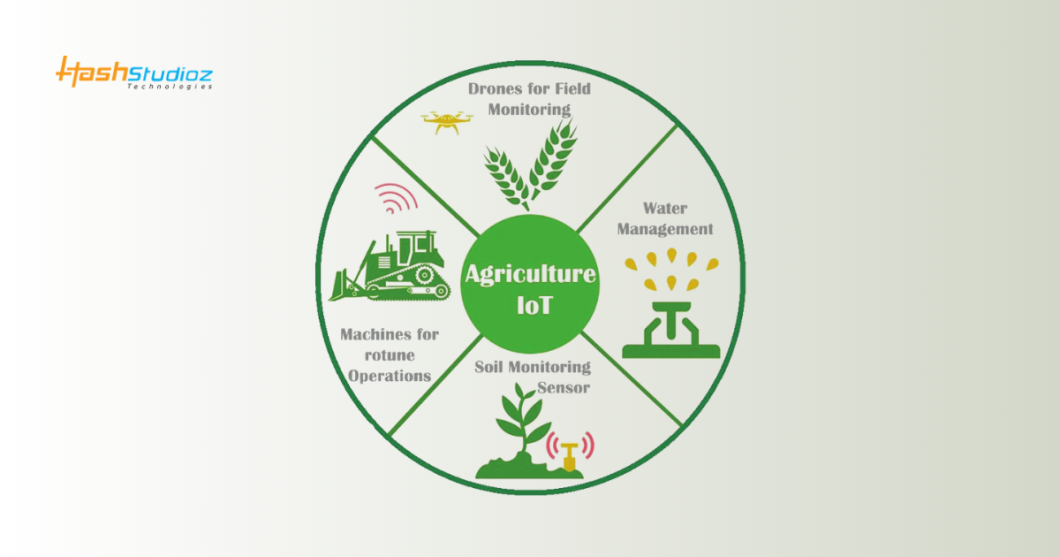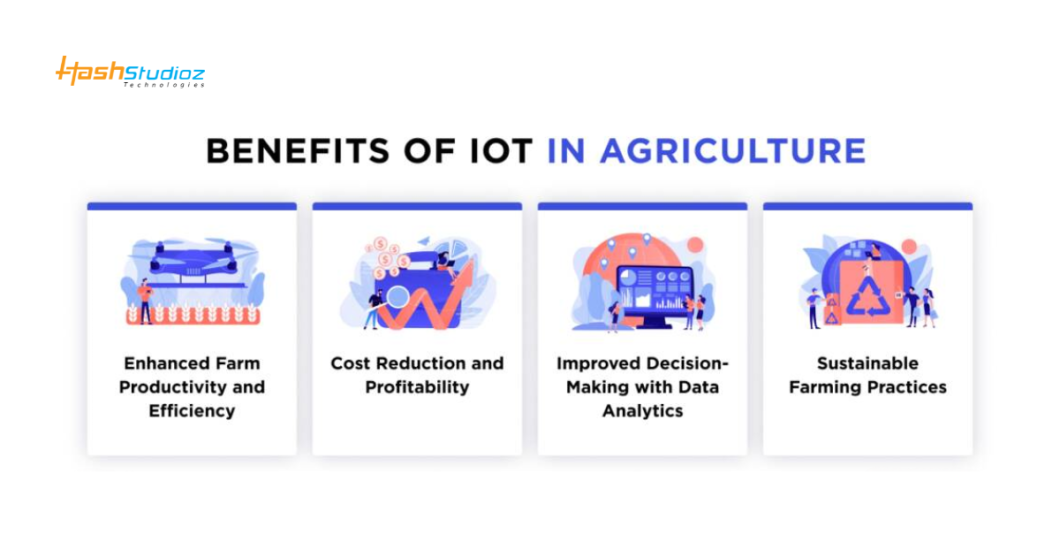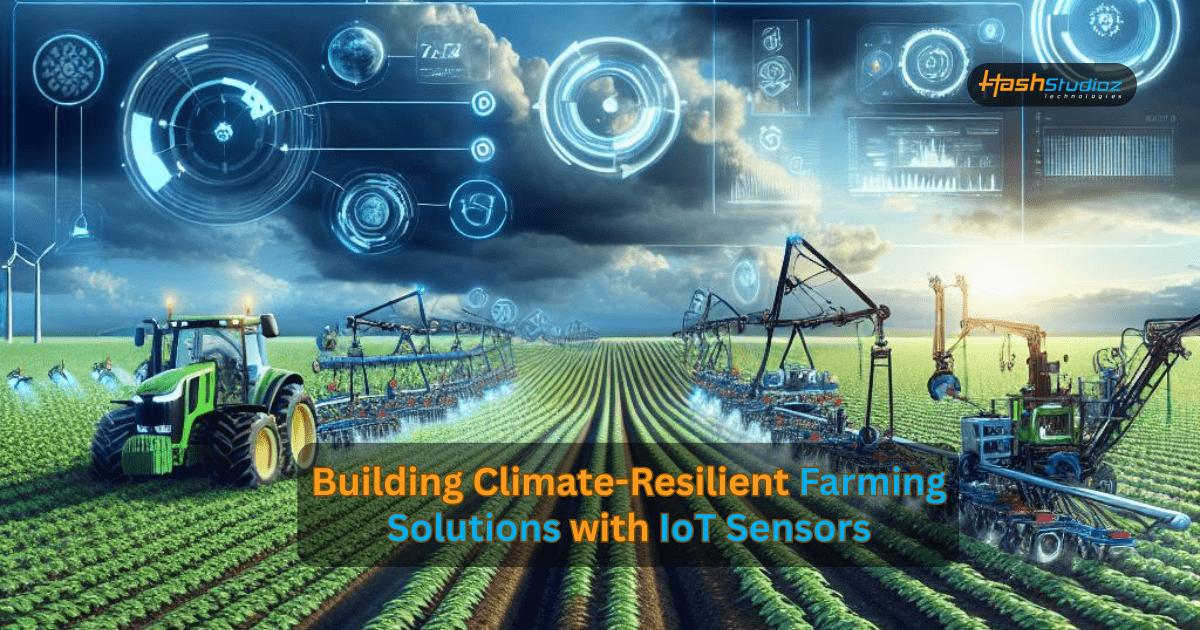Climate change poses significant challenges to agriculture, affecting crop yields, water availability, and overall food security. Traditional farming methods often fall short in adapting to these changes. However, the integration of Internet of Things (IoT) sensors into farming practices offers a promising solution. By enabling real-time monitoring and data-driven decision-making, IoT sensors facilitate the development of climate-resilient farming solutions. This article explores how IoT sensors contribute to smart agriculture and presents practical examples of their application.
Table of Contents
Understanding Smart Agriculture
Smart agriculture refers to the use of advanced technologies, including IoT sensors, data analytics, and automation, to enhance farming practices. These technologies enable farmers to monitor and manage their crops and livestock more efficiently, leading to increased productivity and sustainability.
Key Components of Smart Agriculture
- IoT Sensors: Devices that collect real-time data on soil moisture, temperature, humidity, and other environmental factors.
- Data Analytics: Tools that analyze sensor data to provide actionable insights for decision-making.
- Automation: Systems that perform tasks such as irrigation and fertilization based on sensor data, reducing manual labor and resource use.
Role of IoT Sensors in Climate-Resilient Farming
IoT sensors play a crucial role in building climate-resilient farming solutions by providing accurate and timely data that helps farmers adapt to changing climatic conditions.
1. Precision Irrigation
Water scarcity is a growing concern in agriculture. IoT-enabled soil moisture sensors allow farmers to monitor soil conditions in real-time. By integrating this data with weather forecasts, smart irrigation systems can deliver water precisely when and where it’s needed, reducing water wastage and ensuring optimal crop growth.
Example: In California, CropX’s soil sensors have helped farmers reduce water usage by up to 25% while maintaining crop yields.

2. Soil Health Monitoring
Soil health is fundamental to sustainable agriculture. IoT sensors can measure soil pH, nutrient levels, and temperature, providing farmers with insights into soil conditions. This information enables the application of fertilizers and amendments in precise amounts, promoting soil fertility and reducing environmental impact.
Example: AgWeatherNet in Washington State uses over 175 sensors to monitor soil temperature and moisture, helping farmers optimize irrigation schedules and prevent crop damage from frost.
3. Pest and Disease Detection
Early detection of pests and diseases is vital for minimizing crop loss. IoT sensors, combined with image recognition technologies, can identify early signs of pest infestations or disease outbreaks. This allows for timely intervention, reducing the need for chemical treatments and minimizing environmental harm.
Example: AI-powered cameras used in various farms can detect pests early, enabling immediate intervention to prevent infestations.
4. Climate Monitoring and Forecasting
IoT-enabled weather stations provide real-time data on temperature, humidity, rainfall, and wind speed. This information helps farmers anticipate weather changes and make informed decisions about planting, harvesting, and other critical activities.
Example: AgWeatherNet’s network of sensors helps farmers in Washington State predict and warn of crop hazards such as freezes and hailstorms.
Benefits of IoT-Driven Smart Agriculture Solutions
The application of IoT sensors in modern farming is reshaping how agriculture is managed and executed. These smart agriculture solutions provide real-time data, enabling more precise and data-driven decision-making. Below are the key benefits in detail:
1. Increased Efficiency
IoT-enabled systems significantly improve farm operations by automating routine tasks and reducing human intervention. For example, automated irrigation systems use real-time data from soil moisture sensors to water crops only when necessary. This reduces the need for constant manual monitoring and field checks. Similarly, automated pest control systems release biological agents or pesticides only when specific pest thresholds are detected.
This efficiency is not only about saving time. It also reduces labor costs and limits human errors that can arise from manual decision-making. In large-scale farming, this kind of automation is essential to maintain consistency and manage operations across large areas.

2. Cost Savings
One of the most immediate advantages of smart agriculture solutions is the reduction in input costs. IoT sensors provide detailed data about soil conditions, moisture levels, temperature, and crop health. With this data, farmers can apply water, fertilizers, and pesticides in precise amounts and only where they are needed.
For instance, variable rate technology (VRT), which integrates with IoT data, allows farmers to apply fertilizers at varying rates across a field based on soil nutrient data. This approach minimizes waste and reduces the amount of chemicals required per hectare. Over time, these small savings per application accumulate into substantial cost reductions, especially in high-input farming systems.
3. Enhanced Productivity
Using IoT sensors allows farmers to understand the conditions of their fields at a micro level. Crop performance can be monitored continuously, enabling faster and more effective responses to issues like water stress, pest infestations, or nutrient deficiencies. This type of timely intervention is often the difference between average and high yields.
Data-driven decisions also optimize planting schedules, irrigation timing, and harvesting periods. For example, farmers using IoT solutions for real-time crop health monitoring can identify underperforming zones and take corrective action quickly. According to a study by McKinsey, smart farming technologies can increase farm productivity by up to 25%.
4. Environmental Sustainability
Agriculture accounts for a significant share of global greenhouse gas emissions and water usage. IoT technology contributes to environmental sustainability by promoting more responsible resource management.
- Water Conservation: Soil moisture sensors ensure that irrigation occurs only when necessary, conserving water in drought-prone regions.
- Reduced Chemical Use: Precision agriculture reduces excessive fertilizer and pesticide application. This lowers the risk of runoff into nearby water sources and protects biodiversity.
- Reduced Fuel Consumption: Efficient route planning and machinery operation based on real-time data can minimize unnecessary fuel use in large farms.
5. Improved Food Security
As climate change introduces more variability and uncertainty into food production, IoT-driven smart agriculture solutions help stabilize supply by increasing resilience. When farmers have access to real-time information about crop health, weather conditions, and soil status, they can make better decisions that reduce the likelihood of crop failure.
Additionally, early warnings from IoT systems about adverse weather or pest outbreaks give farmers more time to respond, thus reducing the chances of large-scale losses. Predictive analytics tools, which integrate IoT data, can help forecast yield outcomes and guide logistics for harvesting and storage.
This reliability in food production contributes directly to food security, especially in regions where agriculture is a primary economic activity. It also supports supply chains by ensuring a more consistent and traceable flow of agricultural products from farm to market.
Azure Synapse vs Snowflake: Choose the Right Data Platform for Your Analytics Needs
Challenges and Considerations
Despite the many advantages offered by IoT sensors in smart agriculture, several challenges need to be addressed for wider and more effective adoption. These challenges are especially relevant in rural and developing regions, where infrastructure and resources may be limited.
1. High Initial Costs
The cost of deploying IoT-based smart agriculture solutions can be a significant barrier, particularly for small-scale and marginal farmers.
Breakdown of Costs:
- Sensors: Devices that monitor soil moisture, temperature, humidity, and crop health vary in price depending on accuracy and features.
- Gateways and Controllers: These connect sensors to the cloud or local servers, and are essential for real-time data transfer.
- Software Platforms: Many solutions require subscription-based software for analytics and control.
- Installation and Maintenance: Setting up the system, calibrating sensors, and maintaining hardware adds to operational costs.
For small farms, where profit margins are tight, investing thousands of dollars in IoT systems may not be immediately feasible. Although long-term returns can be high, the upfront investment discourages early adoption.
Example: A basic smart irrigation system using IoT sensors may cost between $1,000–$3,000 per acre, which is unaffordable for many smallholder farmers without subsidies or external support.
2. Technical Expertise
The successful operation of IoT solutions depends on the user’s ability to install, operate, and interpret data from these systems.
Common Skill Gaps:
- Sensor Calibration: Improper setup can result in inaccurate readings.
- Software Usage: Understanding dashboards, interpreting graphs, and setting up alert systems requires digital literacy.
- Troubleshooting: Regular maintenance and updates may require IT support.
In many agricultural communities, especially in developing countries, farmers may not have access to proper training or technical support. Without adequate education, even a well-designed IoT system can fail to deliver results.
Consideration: Programs that provide user-friendly interfaces, multilingual support, and community training workshops can help bridge this gap.
3. Data Management
IoT systems generate large volumes of data continuously, including soil parameters, weather metrics, machine status, and more. Managing this data presents multiple challenges:
Data-Related Issues:
- Storage: Data from sensors must be stored securely, often in the cloud, which comes at a cost.
- Analysis: Raw data is not useful without proper interpretation. Farmers need analytics tools that convert it into actionable insights.
- Data Overload: Too much information can lead to confusion, especially if it’s not filtered or prioritized properly.
Farmers and agribusinesses must decide which data is most valuable and how to act on it. Without proper decision-support systems, the volume of information can become overwhelming.
Solution Direction: AI-based dashboards and data visualization tools can help users interpret data more efficiently, but again, they come at a cost and require training.
4. Connectivity Issues
Many of the world’s agricultural areas are in rural or remote locations where internet access is unreliable or nonexistent. This lack of connectivity creates several complications:
Key Challenges:
- Real-Time Monitoring: IoT sensors rely on continuous communication with cloud servers. Without a stable internet, real-time updates are delayed or lost.
- Cloud-Based Control Systems: Automated irrigation and alert systems may fail without reliable communication between devices and servers.
- Limited Access to Software Updates: Software improvements and security patches may not reach remote devices, leaving them outdated or vulnerable.
In countries with weak digital infrastructure, this remains a major challenge. Although satellite and LoRaWAN-based IoT networks are gaining popularity in remote areas, they still require investment and regulatory support.
Case Example: In parts of sub-Saharan Africa, less than 30% of rural areas have access to stable 4G networks, significantly limiting the reach of IoT-based agricultural platforms.
Future Outlook
The future of climate-resilient farming is closely tied to technological innovation. As global food systems face increasing pressure from climate change, population growth, and resource constraints, smart agriculture solutions will continue to evolve. The integration of advanced technologies such as Artificial Intelligence (AI), drones, and blockchain with IoT systems will further enhance efficiency, precision, and transparency in agriculture.
1. Integration with Artificial Intelligence
Artificial Intelligence (AI) is becoming an essential companion to IoT in agriculture. While IoT sensors collect real-time data from the field, AI systems can process this data at scale to extract actionable insights and automate decision-making.
Key Applications:
- Predictive Analytics: AI algorithms can forecast pest outbreaks, disease risks, or crop stress based on environmental patterns and sensor data. This allows for proactive measures rather than reactive ones.
- Decision Support Systems (DSS): These tools help farmers decide when and where to irrigate, fertilize, or harvest. They are built using AI models trained on historical and real-time data.
- Yield Forecasting: AI-powered analytics can estimate crop yields well before harvest, enabling better supply chain planning.
Example: A system combining IoT and AI can automatically identify a decrease in chlorophyll levels using multispectral data and trigger alerts about potential nutrient deficiencies.
2. Use of Drones and UAVs
Unmanned Aerial Vehicles (UAVs), commonly known as drones, are transforming large-scale farm monitoring. When equipped with cameras, thermal sensors, and GPS modules, drones become powerful tools for data collection, especially in areas that are difficult to reach.
Advantages:
- Large-Scale Surveillance: Drones can scan hundreds of acres within minutes, capturing high-resolution images that reveal crop stress, irrigation issues, or pest infestations.
- Aerial Mapping: Drones generate 3D models and elevation maps of fields, useful for identifying drainage issues or terrain-based planting strategies.
- Targeted Application: Some drones are equipped to spray pesticides or fertilizers in targeted zones, reducing overall usage and environmental impact.
Use Case: In precision viticulture, drones equipped with multispectral cameras monitor grapevine health and identify early signs of disease. The data is sent to IoT platforms where AI algorithms analyze it and suggest treatments.
3. Blockchain for Traceability
As food safety becomes more critical and consumers demand transparency, blockchain technology is being explored for agricultural supply chains. When combined with IoT, blockchain can create tamper-proof, transparent records of a product’s journey from farm to table.
How It Works:
- IoT sensors collect data such as harvest time, temperature during storage, and transport conditions.
- This data is uploaded to a blockchain ledger, ensuring it cannot be altered.
- Each step in the supply chain is recorded and accessible to all stakeholders, including end consumers.
Benefits:
- Food Safety: In case of contamination, blockchain enables rapid traceability to the source.
- Consumer Trust: Transparent supply chains build brand credibility and consumer confidence.
- Compliance: Helps meet international standards for food traceability and safety.
Example: IBM’s Food Trust project uses IoT and blockchain to track agricultural products like lettuce and pork from farm to shelf. The time to trace the origin of food items has reduced from days to seconds.
Partner with HashStudioz for Smart Agriculture Solutions
At HashStudioz, we empower farmers, agribusinesses, and governments with cutting-edge IoT, AI, and data analytics solutions. Whether you’re starting small or scaling big, we’ll tailor a solution that meets your unique agricultural needs.
What We Bring to the Field:
1. Free Expert Consultations – Let’s talk about your challenges and goals—on us.
2. Tailored IoT Deployments – Precision tech that fits your crop, climate, and budget.
3. AI-Driven Dashboards – Real-time insights that help you make faster, smarter decisions.
4. Drone & Blockchain Integration – Monitor, trace, and optimize every inch of your farm.
Ready to Transform Your Farm? Partner with HashStudioz for Smart Agriculture Solutions

Conclusion
Building climate-resilient farming solutions with IoT sensors represents a transformative approach to modern agriculture. By providing real-time data and enabling informed decision-making, IoT sensors help farmers adapt to changing climatic conditions, optimize resource use, and enhance productivity. As technology continues to evolve, the integration of IoT in agriculture promises a sustainable and secure food future.

